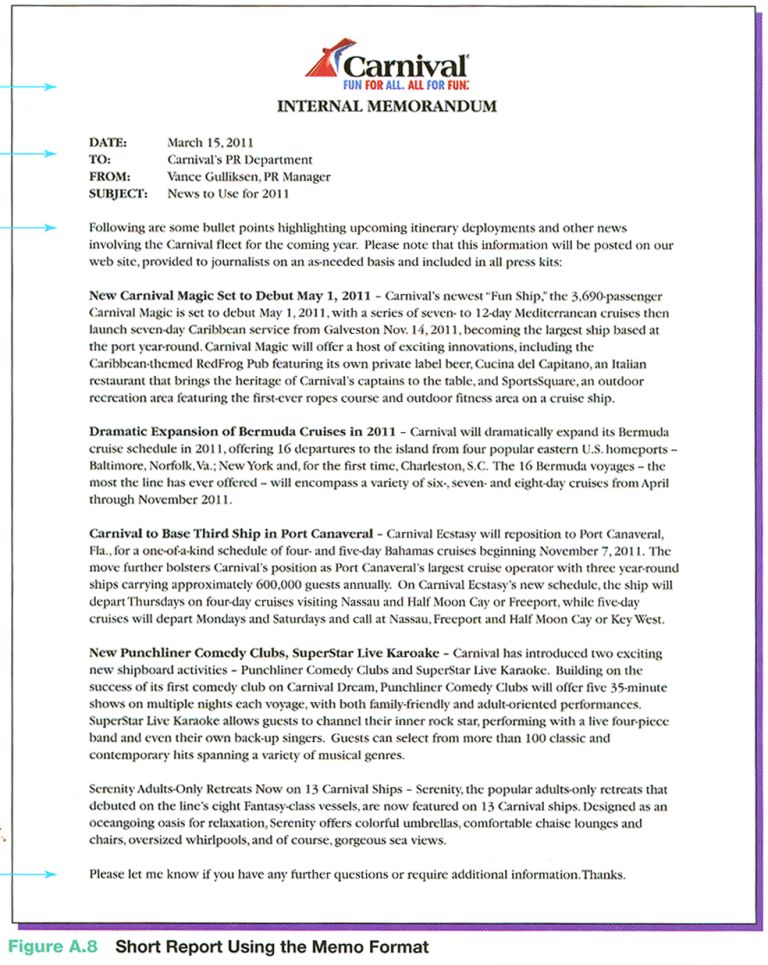
How to Write the Perfect Memo
Please watch the video below for instruction on how to write a typical business memo. Suggestion: Click on the cog icon at bottom right and choose 720p to watch the video in HD.
Memo Checklist
 |
Does identifying information conform to organization standards and preferences? |
 |
Is the memo's purpose clearly stated at the start, or is there a valid reason for not stating the memo's purpose in the opening paragraph? |
 |
Are headings (major and minor) as well as short paragraphs (5-8 sentences) used throughout to improve readability and comprehension? |
 |
If needed is adequate background information provided? |
 |
Is the discussion logical? Unlike dashing off an email, a memorandum should usually be outlined first. |
 |
Are action items highlighted at the end of the memo? |
 |
If there are subsequent pages beyond the first, are these pages on plain paper, not stationery, with a running head and page number? |
Video
Transcript
One of the most common business documents
today is the memo or memorandum.. It's a format that most of use have experience with, reading them if not
already writing them. And
that’s one of the pitfalls of the memo format—it is so familiar and
common that we tend to take it for granted that we can do an acceptable memo
already.
But like another form of
common business communication, email, that assumption can sometimes get us
into trouble. Perhaps it
best to start with the basics and find out exactly what we do and don’t
know about the various types of memos. What don’t we start with a
definition:
Three Key
Memo Traits
First, it is an internal
document. This is helpful because you are more likely to know both the
primary audience (those to
whom it is addressed) and the secondary audience (those who may read it
without your knowing). That more
intimate knowledge of the audience gives you an advantage in comparison
to letters that fly outside the office and immediately become public
documents.
Second, a memo is brief.
Usually one page, two pages at most. Certainly there are special types
that can be
longer, but it is best to
think of the memo as a one-pager, longer than an email, but usually not
a complex
multipage document.
Third, is the memo’s
utility in a company or work unit—from routine reports and
notifications to the proposal memo and even the memo of
understanding—a type of legal document.
How
Relevant Are Memos Today?
But, you ask, aren’t written
memos sort of relics of the past, like transistor radios or Commodore
computers?
Yes and no. Sure, today’s
forms of electronic communication dominate the workplace—from emails to
IMs, blog posts to Skype
chats.
But, there are still
specific reasons and occasions when you will need to produce a written
memo. Some of
these reasons and occasions
are:
When you want to stand
out in the flood of digital communication. Who isn’t overwhelmed by
email every
day in the workplace? But
how many attractive printed documents are gently laid upon our desks?
Two, that printed
document forces the recipient to take hands off the keyboard, hold your
actual work in their actual
hands, sit back and read it. Now be honest—do you read all emails, or
do you scan most of them? Sometimes
not even open them, depending on the subject line?
Three, with today’s
advanced word processing software, you can control precisely how your
document looks,
and sometimes a certain look
is what you need to make your point or to win your audience. Having
this ability also allows
you to control the level of formality that you desire, whereas most
email by definition is usually assumed to be informal before it is
opened.
The Audience Rules
They say there is only one rule for writing: THERE ARE NO RULES. That's
because THE AUDIENCE RULES. In other words, what best communicates your
purpose to a given audience is exactly how you should write and exactly
what you should
include in the writing.
When it comes to memo
writing—which is, remember, an internal document—there are three
potential
audiences:
- a superior
- an equal
- a subordinate.
So no matter what else, always consider the best way to address
these three primary audiences as you are applying these memo standards—and remember never to talk
down to a subordinate.
The Company Rules
Not only does the audience rule, so does the company when it comes to
writing memos. What your company or workgroup has set standard for memo
style—or any type of writing really—is exactly what you should follow, regardless of what any video or
textbook tells you.
Sometimes these rules are
called House Style and some organizations even provide style guides
you must follow. If there
aren’t any published guidelines, then you should simply look at recent
memos from respected. successful
employees and find out answers to questions like:
- Should you use company letterhead stationery for your first page (letterhead is usually not continued after the first page of a memo)?
- For recipients, should you list full names (first and last), or last name and initials only?
- Should you include job titles after the recipient’s name (job titles add extra information that can make the memo more useful for future readers)
- What typeface (font) and point size are preferred?
- Should you handwrite
your initials by your name on the From line?
Commentary on Sample Memo
Let’s take a look at
a standard company memo, then identify its parts and best practices, keeping in mind that a
particular company’s house style should always take precedence.
Here we see a pretty
typical memo that begins its first page on company letterhead.

Sample memo from Bovee & Thill,
Business Communication Today (11th ed.). Pearson, 2012.
Heading Alignment: One
common mistake is not using aligned columns for the headings TO, FROM
and SUBJECT, which is standard, as is boldfacing the headings. Sometimes a company may prefer RE: or
Regarding. DATE: If there is no company style
such as centering it under the word Memorandum, also place it in the
column of headings.
Recipent alignment: After each
heading is a colon, then the item it points to. These items should also
be column aligned
Subject line: This is one of the most important parts
of your memo. It should:
Be specific: The subject line hould be as specific
as possible. Consider it a summary of the memo in non-sentence form.
For example:
“Expense Reimbursement for January 401K Seminar”
“Procedure for Expense Reimbursement--January 401K Seminar”
Use
title capitalization: The subject line is capitalized as if it
were a title, which means the first and last words, no matter what they are, are
capitalized. All major words in-between are also capitalized except for
articles (a, an, the) and
prepositions (for, to, of).
Statement of purpose: Next, begin
your memo with a clear statement of purpose. It’s fine to write as your
first sentence, “The purpose
of this memorandum is to . . . .” Remember the axiom: “First be clear,
then you can be clever.” The
two exceptions to statement of purpose rule are:
- if the intended reader needs background information to set the stage before getting into the meat of the memo
- if you know you reader
is skeptical, hostile or otherwise likely to disagree. Then you have to
soft sell the opeing a bit
more.
Purpose verbs: For your subject
heading and purpose statement, take the time to choose an accurate
“purpose” word. Keep a
list of the handy. The purpose of a memo can be to:
| review assess propose recommend evaluate |
explain describe outline inform forecast |
authorize illustrate report offer summarize |
Subtitles/subheadings:
Use clear subtitles or subheadings to signal the organization of the
memo. All subtitles must be styled
the same, including the exact same spacing before and after.
Paragraphing: Use short paragraphs
of 5-8 sentences, which is preferred business style, along with lists
and tables when
appropriate instead of sentences. Examples—a bullet list for providing
steps in a procedure, or a table of dates and production numbers.
Action steps: End with action steps.
What happens next? What do you want the reader(s) to do? Or what will
you do?
No closing: One of the primary
differences between a letter and a memo is that the memo does not have a complementary closing or
signature.